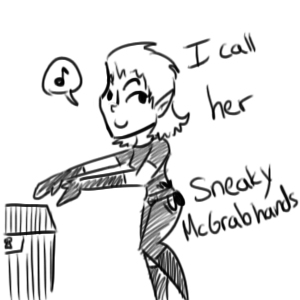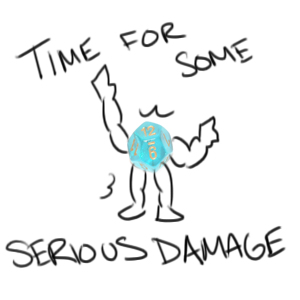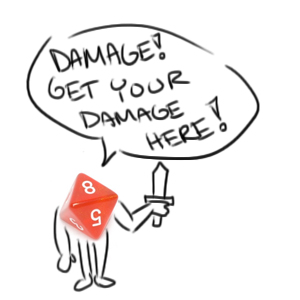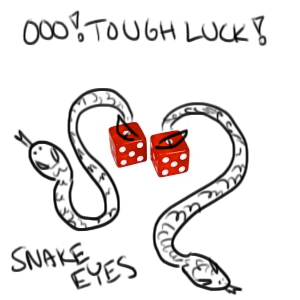I sat glancing through my character’s sheet, looking for the spell I’d use on my turn. A friend’s character narrowly dodged a flying table with a lucky dice roll. I hoped my dice would favor me as well… then again I suppose I’ve had my share of lucky rolls in the past.
My turn is called in combat and a sling a spell at the ghastly opponent… My d20 bounced against the table once, twice…

The armless ghost dissolved slowly, a look of peace crossing her transparent features.
“Don’t worry, your daughter is safe.” I say, watching her fade.
“Thank you…” is her last breathless whisper. I clutch my fists, knowing that this maid’s fate wasn’t even the worst in this manor. How many tortured souls still roam these halls? And where was the lady that owns this cursed place?

“A few necromancers are nothing! Do not let them slow our path!” I shouted as an aura of crackling black lightning struck those around me. These peons were just buying time for the ritual to be completed. As long as I still lived that demonic herald would not be allowed into this realm! They shall know the wrath of May Morwen, priestess of the Dark Lady, for I will bring my goddess’s power upon them! Goddess be with me!

I travel through the decrepit halls, careful not to disturb the shambling corpses nearby. My companion’s spell hid us from their putrid sight, though to interact with them would make us seen. Checking each open door for survivors we come across a few manor knights confined to chairs. Their eyes are glossy and unresponsive but their chests still heaved with living breath. A holy symbol frees them from their enchantments, bodies shaking from the taint of their possessed lady. One bolts down the hall, shouting for his lady, even while knowing she was not herself. How can someone be so weak? To cling to an illusion of happiness rather than forging your own… We follow him to her, slowly learning what we’re up against.

“We’re not going to make it in time!” Someone shouted beside me. “Don’t lose your hope, this is not the end!” I replied, patting his shoulder as he ran nearby. In the distance I saw the summoning circle, dark mages moving around it. I ignored the bodies of their sacrifices we passed as I mentally promised their vengeance. Fate would not allow this to be so. We will make it. We will succeed.

Following the foolish knight, we find the ‘lady’ sitting in the uppermost hall. She lightly caresses his head as he swears vows of loyalty and service. The smile on her face is unnatural, as is her gaze.
“I know why you’re here, adventurers.” She announces, her voice has an odd, deeper echo after each word. The ring on her finger seems to draw away the light in the room, a darkness surrounding it as she twists it on her finger.
“I will give you what you desire… if you allow me to leave unharmed.” Her eyes glint serpentine for the barest moment. “I have no wish to fight you and you will never see me again… this much I promise.” A second face appears over the lady’s, a demonness’… She smiles, sweetening the deal further. “I will even offer you another boon… should you let me pass…”

A long shadowed hoof materialized in the circle as a few dark mages dropped after being drained. “It’s almost here! The herald is coming!” Between us was the final obstacle, the Demon Summoner himself. He would pay for his crimes, for all the souls he stole away. So many lives denied the afterlife. I felt a rage build inside, my Goddess’s eyes were on me.

“We do not make deals with demons!” My druidic friend says, motioning for us to get into battle position. I am the only one that pauses. Didn’t he realize the demon’s power was far beyond our own? The demoness only smiles, opening her mouth so utter a word so foul that the hall windows shatter and we feel it in our very souls. I look to my sides and notice that everyone is frozen from its blasphemy, and yet I still move.
“You do not seem as foolish as your companions… Surely you have sense enough to take my deal…” She steps towards me, the knight still at her feet groveling for her illusionary happiness. My mind is reeling with possible actions, but my logical side is shouting that we will all die otherwise. That our quest will end here… that so many would die if we made a stand here and get wiped away… “D…don’t…” The druid groans, trying to free himself from the spell. What can I do?

Time is running out. The Demon Summoner is doing his best to keep us here, and while victory is at hand it will be far too late to stop the ritual. Something had to be done. A risk had to be taken. I shout for our warrior to defend me a moment as I ran forward, hand outstretched. My goddess had a plan for me. This had to be it. I believed in it with all my mind, body and soul. I can stop this. I will stop this.
The herald was materializing as I neared, laughing at my vain attempt to stop him. “Soon this world will be eclipsed into darkness… soon Azozel will reign supreme and feast upon your souls…” The time was now!
“BY THE DARK LADY I BANISH YOU DEMON, BACK TO THE INFINITE ABYSS! YOU SHALL NOT TAINT THIS LAND WITH YOUR TOUCH!”

“You’ve chosen well, mortal…” I watch her fade into the shadows, taking the lady’s body and the knight with her. My companions are free, and staring at me with disgust. They cannot understand why I would accept her offer. They cannot see past the glory of doing what is right and just. It seems only I see the value in the information gained from the demoness… The exact location and time of our enemy’s attack. The ring rests in my hand as well. In my eyes, the quest was a success…

The herald’s eyes widen as his body starts to disappear, his anchor to this realm broken. “How…” I smiled, watching him feel the power of my deity. “The goddess is strong within me. She watches over all. Today her strength is my own.” A simple spell of dismissal, so weak and frail an incantation, was the demon’s demise.
I glanced at my d20, grinning at the natural 20 I rolled.

Natural 20. My roll was successful, but no one could agree with my choice. I looked around our living room, noticing shaking heads and murmurs. Sometimes it didn’t matter what you rolled, but what you did with it.





















































